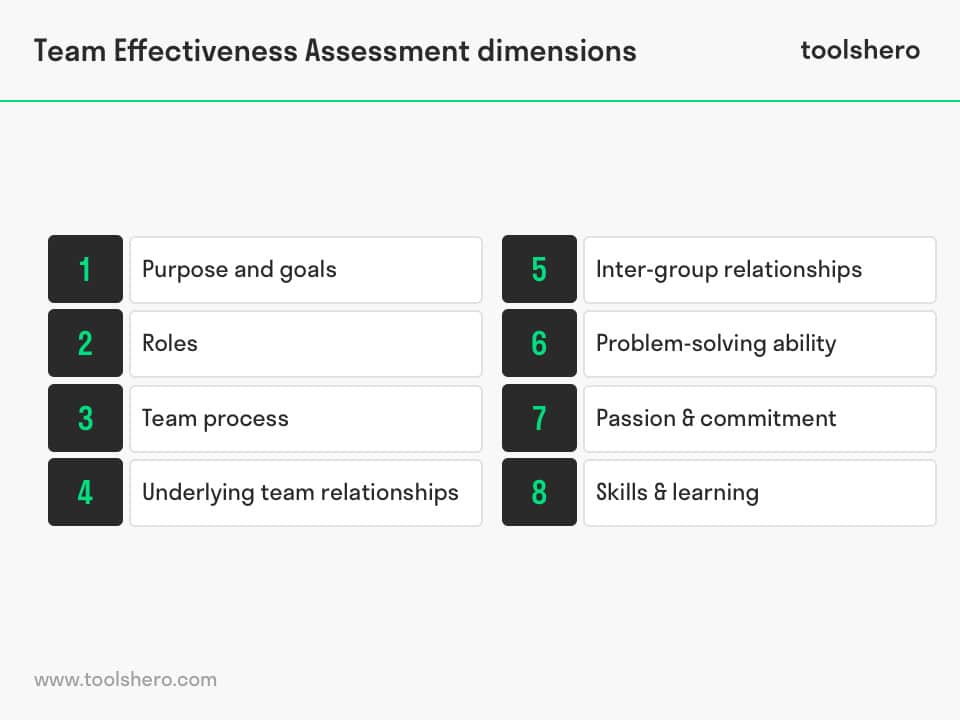Team Effectiveness Assessment

Team Effectiveness Assessment: this article offers a practical explanation of the Team Effectiveness Assessment. After reading, you’ll have a basic understanding of this powerful team management tool. This article also contains a downloadable and editable Team Effectiveness questionnaire.
What is the Team Effectiveness Assessment?
The more effectively a team is coordinated, the better the performance of the department will be. Based on the Team Effectiveness Assessment (TEA), businesses can discover what their departments’ strengths are, and what they could improve. Organisations work with large and small teams within their departments.
Basically, organisations are made up of teams. Despite that, many teams have difficulty with functioning efficiently. Team Effectiveness Assessment helps managers gain insight into the strengths of teams and in which areas they can improve.
It isn’t just employee diversity that creates strong teams; composition, loyalty, trust, and engagement also play important roles within teams. For organisations it’s mainly important that people are goal oriented and that they work according to a plan.
Therefore, the key to success is in creating teams that perform well. Research shows that effective teams have several characteristics in common, regardless of their industry, job, or size. What these characteristics are and how they can be measured was described by the American organisational and team management author Patrick Lencioni in his book, ‘The Five Dysfunctions of Teams’.
By having each team member complete a survey that’s exclusively focused on team interaction and team processes, the most important aspects of team effectiveness are revealed.
However, Team Effectiveness Assessment goes beyond interpersonal relationships; it’s about measuring organisational support, goal orientation, team diversity, learning, growth, and results. By comparing team results to the real-life teams with strong performance, Team Effectiveness Assessment can help to teams to do better.
Characteristics of an effective team
A poorly performing team can lead to significant issues and dramatically affect organisational performance. A team that isn’t working, often leads to unnecessary disruptions and strategic failures.
An effective team on the other hand will lead to good results. Such a successful team consists of a diverse group of employees with complementing skills required to do the work.
They communicate in an open way and respect the input of each individual team member.
They are focused on working together and know that they are dependent on each other’s efforts. Together they bear responsibility for the results and look for coordination, integration, and synchronisation of everything they do.
In addition, the group is motivated because they are given the chance to grow personally and professionally. That motivates each team member to give it their all to complete their tasks in the best possible ways and work together. They are engaged and consider their jobs to be a meaningful challenge.
Five sub-areas
Working with an effective team doesn’t have to be difficult. In the book ‘The Five Behaviors of a Cohesive Team’, a follow-up to the previously mentioned book ‘The Five Dysfunctions of a Team’ by Patrick Lencioni, he mentions five different sub-areas that are also vital to effective teams.
Improving the team will elevate organisations to a higher level of effectiveness as well. Most of all, it reduces stress and dissatisfaction among employees. The following sub-areas lead to effective teams:
Trust
When team members trust each other, they feel at ease and are able to show vulnerability by not being afraid to talk about their failures and weaknesses. They know they can come to each other for feedback and helpful tips.
No conflict avoidance
Team members who trust each other are also not afraid to make their disagreement known. They know that this can serve to stimulate each other and find the best ideas and solutions. By just agreeing with everyone, the risk is that the best solution is never found.
Decide together
Making joint decisions creates team engagement. That means that there’s room for discussion prior to a decision. Everyone is free to share their opinion and respond to others.
Hold each other responsible
When a team makes joint decisions, they can also hold each other responsible for acting in accordance with those decisions and the related standards. That means they can call each other on things that aren’t going well.
Focus on a collective result
After a joint decisions, it’s good for the whole team to focus on the end result that they’re aiming for. Because of the unity, team members will be more willing to put their own interests aside and focus on achieving the collective results.
Team Effectiveness Assessment : Dimensions of effectiveness
Team Effectiveness Assessment helps with identifying general team-related issues. Once the evaluation is complete, focus can shift to improving and developing the most important skills. In general, a Team Effectiveness Assessment consists of a questionnaire that measures team effectiveness based on eight dimensions:
- Purpose & goals
- Roles
- Team process
- Underlying team relationships
- Inter-group relationships
- Problem-solving ability
- Passion & commitment
- Skills & learning
Getting started with the Team Effectiveness Assessment
The individual report summarises the results and enables individuals to compare their view of the team with that of others. The group report shows the results, gives recommendations for team development, and offers templates for improvement and ownership.
The supervisor assesses the team’s effectiveness first. They do so by completing the questionnaire and evaluating team behaviour. Next, each of the effectiveness dimensions of the team is calculated.
After that, it’s up to each individual team member to fill in the same Team Effectiveness Assessment questionnaire to calculate an average rating of each employee.
The evaluations show the highest and lowest scores. The supervisor’s evaluation is then compared to the team averages. Significant differences indicate areas of improvement and serve as input for discussions.
The questionnaires are based on the eight dimensions. For each dimension, seven statements are given, with which a team member can ‘fully agree’, ‘agree’, ‘neutral’, ‘disagree’, ‘fully disagree’. These opinions get a value between 1 and 5.
By writing the evaluations on a score card, you can see the team effectiveness. A numerical value is input in a matrix for the ratings of each of the 56 statements.
Next, the scores are added per dimension. After that, the total is divided by seven to calculate an average for each dimension of team effectiveness, creating an overall score.
How do I use the results of the team effectiveness assessment?
The overall team effectiveness score is a weighted average of all dimensions. If you want to calculate a score for only one dimension, please perform the calculation below. Please note that the maximum score per dimension is 35 (7 questions, max 5 points per question). An example:
24 out of 35 on the dimension of Utility & Purpose? Then the score is (24/35) x 100% = 69%, or a score of 6.9 / 10.
- 10 = Excellent
- 9 = very good
- 8 = Good
- 7 = more than sufficient
- 6 = Sufficient
- 5 = doubtful /weak
- 4 = unsatisfactory
- 3 = largely insufficient
- 2 = poor
- 1 = very bad
Step-by-step action plan for the application of the results
- Identify the dimensions with both the higher and lower scores
- Think of concrete examples from practice that show which factors influence the score
- Identify two or more actions to improve the lower scores for each of these specific situations
- Compare your results with the results of team members. The perspective that team members have of the same team can differ dramatically from each other
- Discuss significant differences in your perspectives and try to identify what led to them
- Specify one or more things you can do to minimise the differences and improve the lowest scores in the future
Team Effectiveness questionnaire
Use this Team Effectiveness questionnaire to assess your team and to get insights regarding the different dimensions of effectiveness. Available as an editable template.
Download the Team Effectiveness questionnaire
This template is exclusively for our paying Toolshero members. Click here to see if a membership is something for you!Now It’s Your Turn
What do you think? Do you recognize the explanation of the Team Effectiveness Assessment? In your opinion, are the effectiveness dimensions complete or are you missing another aspect? Do you have any tips or additional comments?
Share your experience and knowledge in the comments box below.
More information
- Bateman, B., Colin Wilson, F., & Bingham, D. (2002). Team effectiveness–development of an audit questionnaire. Journal of Management Development, 21(3), 215-226.
- Lencioni, P. (2006). The five dysfunctions of a team. John Wiley & Sons.
- Lencioni, P. M. (2007). The five dysfunctions of a team: Participant Workbook (Vol. 8). John Wiley & Sons.
How to cite this article:
Mulder, P. (2019). Team Effectiveness Assessment. Retrieved [insert date] from Toolshero: https://www.toolshero.com/management/team-effectiveness-assessment/
Published on: 01/21/2020 | Last update: 03/25/2022
Add a link to this page on your website:
<a href=”https://www.toolshero.com/management/team-effectiveness-assessment/”>Toolshero: Team Effectiveness Assessment</a>













